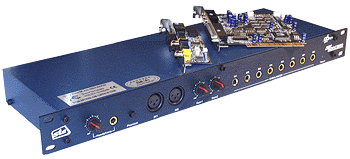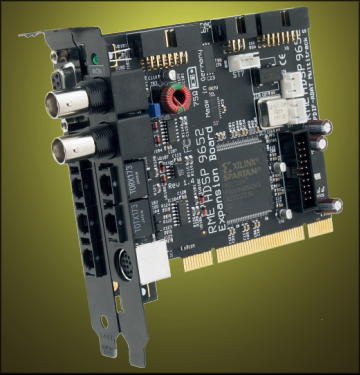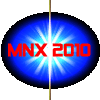| |
MNX2010 PC Audio Sites - Hardware :
Introduction hardware
Naturally there are some minimum requirements involved with soundcards. But it's obvious that for quality, you'll have to pay.
The following are important considerations when buying a soundcard:
-
Good quality connectors: best are gold-plated jack or cinch I/O.
-
Digital I/O for digital audio exchanging without loss of quality.
-
More professional: A DSP AD/DA conversion rate of 24 Bits/96 KHz.
-
For home recording: A PCI card with ADAT for extended optical and analog channels.
-
Modules with 8 i/o's minimum must be compatible with the ADAT standard (I will explain the ADAT standard later on), optical and/or analog.
ADAT, is invented by Alesis, about ten years ago. It's an 8 channel I/O standard. The standard of the modern version (the optical ADAT 8 I/O) is now 24 bit/96 KHZ, although there are some deviations. Beware of this, because these deviations are mostly incompatible! The analog ADAT connector looks like a screen
connector and the optical version is just as big as the stereo SP-Dif version, with the difference that now 8 channels are going through.
cards :
-
The regular 16 bit soundcard -
With a soundcard like this, little demands can be made. Perhaps a surround-option (5.1 / 7.1), or a SP-Dif I/O. Some cards have nice little extra's though, like the Philips acoustic edge series, which have a DSP AD/DA conversion or surround emulation. These soundcards differ in price and quality from junk to decent.
-
Semi-professional soundcards -
Fortunately more and more soundcards are available for semi-professional use. They support mostly only 2 I/O's on 24 bit/96 KHz, have optical and coaxial SP-Dif and MIDI i/o's, gold plated connectors, and audio converting/buffering up to 8 channels. They are in fact the little brothers of the real professional, multi channel I/O systems. Although the price, as well as the latency of these soundcards is still fairly high, we're talking about a quality product which greatly exceeds the common 16 bit soundcard, which makes it a must for good, semi-professional audio recordings.
-
Professional soundcards -
The sample rates of these cards lie between 24/96, and 24/192 KHz. They consist mainly of an internal hardware soundcard, and because there is no room on the PCI card for all the extra channel I/O's, a break-out box. This break-out box houses at least 8 (balanced) i/o's, analog as well as digital (AD/DA converting), SP-Dif and MIDI i/o's, analog and/or digital ADAT, digital sync, and headphone and mic inputs. They will almost certainly have 'stack' (linking) or rerouting capabilities, which make it possible to create an audio system just the way you like it. Notice that in the case of 'stacking' a number of soundcards, the use of similar PCI soundcards is highly recommended (like the Hammerfall, from RME).
Professional & Semi-professional audio systems.
With the arrival of the soundcards mentioned above, the PC becomes more and more a very suitable tool for making (semi) professional recordings. It wasn't even long ago that people were exhilarated by the fact that MIDI and audio were synchronized. Nowadays it's possible to create a complete home recording studio out of your PC with up to 36 or even 48 audio channels, if you have the proper hardware support!
 The possibility of digital processing of these large quantities of audio tracks is mainly due to the ever increasing speed of the processor units and storage room on hard disks. Whilst 8 or 16 audio channels won't pose a problem, the recording of 16 to 48 channels, processed by various plugins like digital effects or the increasingly growing more popular softsynths, definitely will. These problems involve latency, stuttering of the audio, ticks and crackles, crashes of the software etc. In this case the CPU just can't handle the amount of data requested for processing. In this situation, when working with a lot of channels and plugins, it's important that your computer has a fast processor, a lot of internal memory, and a large storage capacity. The speed of CPU's is around 3 GHz nowadays. The amount of internal memory is dependant on the type of motherboard you're using, the number of memory slots demands upgrading to 1,5 or 2 Gigabytes of RAM.
The possibility of digital processing of these large quantities of audio tracks is mainly due to the ever increasing speed of the processor units and storage room on hard disks. Whilst 8 or 16 audio channels won't pose a problem, the recording of 16 to 48 channels, processed by various plugins like digital effects or the increasingly growing more popular softsynths, definitely will. These problems involve latency, stuttering of the audio, ticks and crackles, crashes of the software etc. In this case the CPU just can't handle the amount of data requested for processing. In this situation, when working with a lot of channels and plugins, it's important that your computer has a fast processor, a lot of internal memory, and a large storage capacity. The speed of CPU's is around 3 GHz nowadays. The amount of internal memory is dependant on the type of motherboard you're using, the number of memory slots demands upgrading to 1,5 or 2 Gigabytes of RAM.
 For the storage of data: I would advice to use hard disks not exceeding 120 GB's at 7200 RPM. Recent motherboards can sustain up to four ATA hard disks which will give you a 480 GB storage capability. In the case this is still not enough, you can always use an extra PCI-IDE card, or serial-ATA… Another possibility (which is my personal favourite) is to use an interchangeable hard disk. Brackets with multiple hard disk trays are available on the market: an excellent solution in my opinion! But beware: please do care about extra cooling because it's very bad for a hard disk to get too hot; an extra ventilator in the tray or on the hard disk itself will definitely extend its lifetime.
For the storage of data: I would advice to use hard disks not exceeding 120 GB's at 7200 RPM. Recent motherboards can sustain up to four ATA hard disks which will give you a 480 GB storage capability. In the case this is still not enough, you can always use an extra PCI-IDE card, or serial-ATA… Another possibility (which is my personal favourite) is to use an interchangeable hard disk. Brackets with multiple hard disk trays are available on the market: an excellent solution in my opinion! But beware: please do care about extra cooling because it's very bad for a hard disk to get too hot; an extra ventilator in the tray or on the hard disk itself will definitely extend its lifetime.
 Computer system
Computer system
When considering buying a computer, first of all it has to be very clear what you want to do with it, and in extent, what you really need. That involves considering extending or upgrading your existing system, or to buy a completely new system. The rule of thumb here is not to buy the newest fancy stuff available. This is because it's expensive and often has 'childhood diseases' and bugs.
Try to be at the 'cutting edge', which means as much as buying stuff which is on the market for a while, giving it the chance to improve (updates/upgrades) and read the (user) reviews with the pros and contras before you buy anything.
Audio systems
Several audio systems, as well as soundcards, exist which can be 'stacked' or linked to one each other. Like ADAT, these systems have 8, 16, 24, 36, 48 or more channels. In the following I will review two of these systems, namely the Hoontech- and the RME system.
 Hoontech DSP 24 system 2000
Hoontech DSP 24 system 2000
Hoontech DSP 24 system 2000 C-Port is an 8 in/out AD/DA module, with extension capabilities. This system is, considering its very high hardware quality and low price, very suitable for semi-professional use, although 'stacking' is only possible with another Hoontech Modules. The DSP 2000 system consists of an internal PCI card with a 25 pins connector to the C-port break-out box. A connector at the back of this module makes it possible to link through to another Hoontech Modules (24/96). For professional purposes is this system not recommended, because in the case of stacking too much modules or PCI cards at the same time, it will be very likely that problems will occur with digital sync (synchronization), latency and I/O sync.
In that case, it will be hardly possible to play a lot of audio tracks while recording another one (full duplex).
 Optical ADAT/RME systems
Optical ADAT/RME systems
The Optical
RME Audio
have a triple optical I/O for 8 channels, which means it has 24 mono i/o channels. This means that with two of these PCI cards, it's possible to achieve 48 mono or 24 Stereo I/O channels! This feature makes it suitable for professional needs. Maybe it's also possible to add a third PCI card.
Because of this system's separate digital sync connector, it's even possible to link multiple PC-systems together, although additional digital sync/interface hardware modules might be required. Software programs like VST System Link, V-Stack and VSL2020 make it possible to make use of this advantage and turn the
Semi professional applications of the PC into a genuine professional digital studio.
A broad range of modules with optical 24/96 ADAT which are compatible with the RME system are available nowadays. In this range, possibilities and quality are in equilibrium to their price. Amongst these modules there also digital mixers (from Yamaha for instance) with optical ADAT support (or expanding capabilities), for use with other modules.
It remains to be seen if even the fastest computer available today can cope with the possibility to stack three RME cards (via optical ADAT) because in real-life situations a whole lot of software (VST) effects and instruments are being processed, demanding the utmost processing power of nowadays CPU's.
 Quality
Quality
The quality of most modules is fairly high. Matters to consider are whether the module has DSP support for AD/DA converting, standard connectors for ADAT and SP-Dif, and a low latency. Certainly in the last mentioned matter, the latency and software support, a lot of problems are still to overcome. Installing the necessary WDM or ASIO drivers are more than often likely to cause trouble. In some cases update drivers will help here.
The price
A fully compatible optical ADAT module will cost somewhere between 400 and 2000 euros/dollars. The cheapest brand is Hoontech, MOTU is the most expensive and RME lies in between. The most expensive system from
MOTU
is in my opinion most advisable in case you really need the best sound quality, software support, large quantity of multi channels and expansion capabilities, and professionality.
The RME modules possess many types of connectors and expanding capabilities, as an expansion it good be very handy.
Last consideration is the sample rate. 24 bits 192 KHz modules are being developed and the standard is likely to be set at 32 bits/192 KHz (or a 32 bits/88.2 KHz my idea ), although that will probably still take a while. For now, the standard of 24/96 is compatible with DVD audio. A step forward, although not for long, would be 24 bits/192 KHz. Because of the everyday increasing computer possibilities a quick change of the existing 24/96 standard to 32 bits/192 KHz would be very logical. Then, the approaching of the quality of an analog recording quality has gone, once again, a step further! ... MNX2010 Oct 2003
|


 The possibility of digital processing of these large quantities of audio tracks is mainly due to the ever increasing speed of the processor units and storage room on hard disks. Whilst 8 or 16 audio channels won't pose a problem, the recording of 16 to 48 channels, processed by various plugins like digital effects or the increasingly growing more popular softsynths, definitely will. These problems involve latency, stuttering of the audio, ticks and crackles, crashes of the software etc. In this case the CPU just can't handle the amount of data requested for processing. In this situation, when working with a lot of channels and plugins, it's important that your computer has a fast processor, a lot of internal memory, and a large storage capacity. The speed of CPU's is around 3 GHz nowadays. The amount of internal memory is dependant on the type of motherboard you're using, the number of memory slots demands upgrading to 1,5 or 2 Gigabytes of RAM.
The possibility of digital processing of these large quantities of audio tracks is mainly due to the ever increasing speed of the processor units and storage room on hard disks. Whilst 8 or 16 audio channels won't pose a problem, the recording of 16 to 48 channels, processed by various plugins like digital effects or the increasingly growing more popular softsynths, definitely will. These problems involve latency, stuttering of the audio, ticks and crackles, crashes of the software etc. In this case the CPU just can't handle the amount of data requested for processing. In this situation, when working with a lot of channels and plugins, it's important that your computer has a fast processor, a lot of internal memory, and a large storage capacity. The speed of CPU's is around 3 GHz nowadays. The amount of internal memory is dependant on the type of motherboard you're using, the number of memory slots demands upgrading to 1,5 or 2 Gigabytes of RAM.
 For the storage of data: I would advice to use hard disks not exceeding 120 GB's at 7200 RPM. Recent motherboards can sustain up to four ATA hard disks which will give you a 480 GB storage capability. In the case this is still not enough, you can always use an extra PCI-IDE card, or serial-ATA… Another possibility (which is my personal favourite) is to use an interchangeable hard disk. Brackets with multiple hard disk trays are available on the market: an excellent solution in my opinion! But beware: please do care about extra cooling because it's very bad for a hard disk to get too hot; an extra ventilator in the tray or on the hard disk itself will definitely extend its lifetime.
For the storage of data: I would advice to use hard disks not exceeding 120 GB's at 7200 RPM. Recent motherboards can sustain up to four ATA hard disks which will give you a 480 GB storage capability. In the case this is still not enough, you can always use an extra PCI-IDE card, or serial-ATA… Another possibility (which is my personal favourite) is to use an interchangeable hard disk. Brackets with multiple hard disk trays are available on the market: an excellent solution in my opinion! But beware: please do care about extra cooling because it's very bad for a hard disk to get too hot; an extra ventilator in the tray or on the hard disk itself will definitely extend its lifetime.
 Computer system
Computer system
 Hoontech DSP 24 system 2000
Hoontech DSP 24 system 2000
 Optical ADAT/RME systems
Optical ADAT/RME systems
 Quality
Quality
